Purple leaf plants are eye-catching shrubs, trailing plants, leafy perennials, purple succulents, and annuals with dark-colored dramatic foliage. They have dark leaves due to increased anthocyanin concentrations in the foliage. This pigment can cause the leaves to turn shades of purple from pale lilac to light pink, mauve, reddish-purple, violet, amethyst, and dark purple.
30 Most Common Purple Leaf Plants
The fascinating thing about purple-leaf plants is that they are attractive and colorful regardless of whether or not they bloom. Here are some of the common purple leaf plants you can plant to add vivid visual appeal to your landscape.
1. Persian Shield
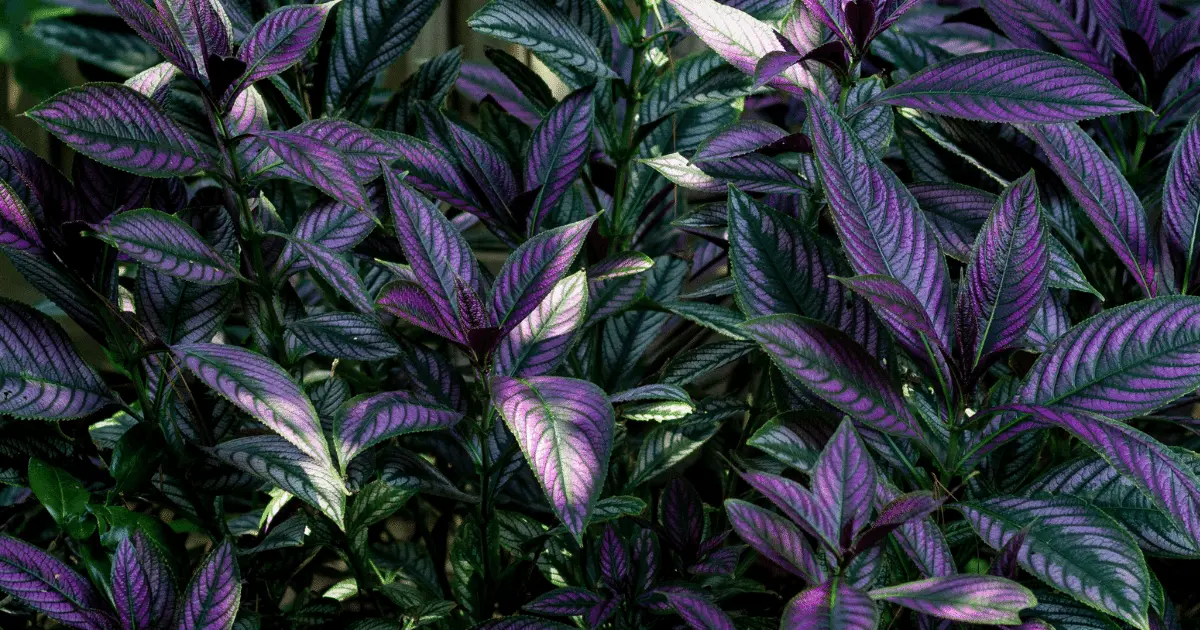
Persian shield (Strobilanthes dyerianus) is a stunning tender perennial with shiny lilac, purple, green, and gray leaves. Persian shade has been grown since Victorian times for its ornamental foliage indoors and outdoors.
This widely-hued foliage thrives best in cool weather but grows quickly under hot and humid conditions to form a large, bushy, mounded plant. It can grow up to 5 feet tall and 2 feet wide but remains smaller in containers or cooler climates.
USDA Growing Zone: Zone 8- 11
Sun Exposure: Full, partial
Soil Requirements: Rich, moist soil
2. Purple Shamrock

Purple Shamrock (Oxalis Violaceae), commonly known as the false shamrock, is a perennial plant with dark purple leaves that are almost black. It is one of the most common species grown as a houseplant with three heart-shaped purple leaves with three sides that sit symmetrically to one another at the end of every stem. The purple shamrock grows 0.5 to 1.5 ft (15-45 cm tall), and its three triangular purple leaves are grown on a stem measuring up to 3″ (75 mm).
USDA Growing Zone: Zone 3- 10
Sun Exposure: Full, partial
Soil Requirements: Loamy, sandy, well-drained.
3. Purple Heart Plant
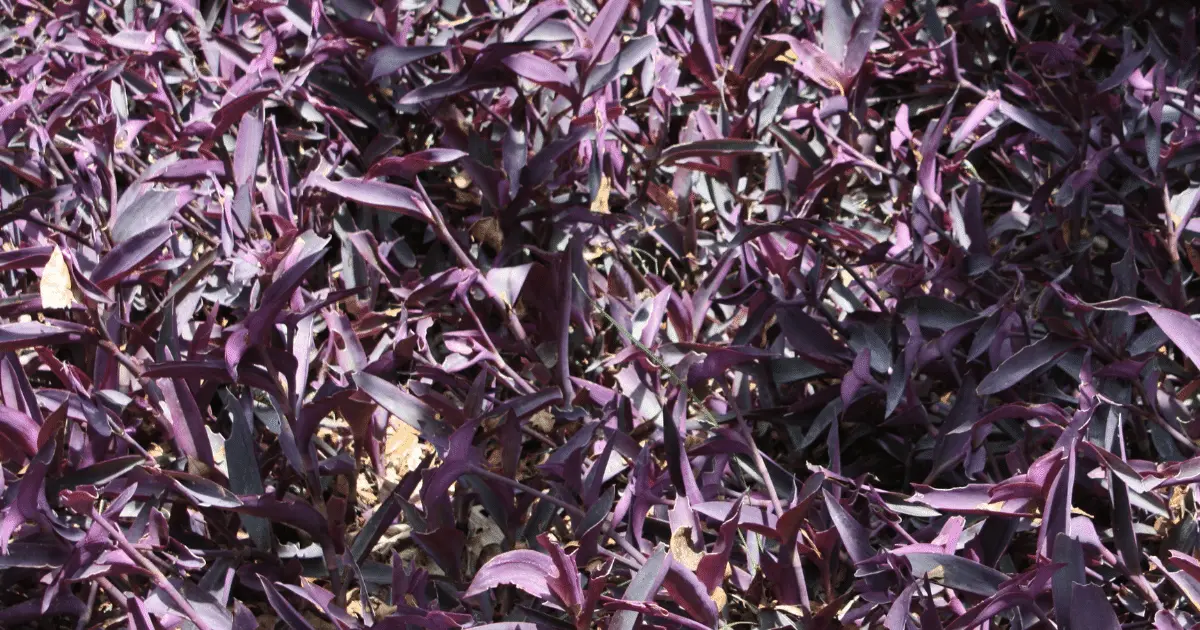
Purple heart plant (Tradescantia pallida), also called purple spiderwort, is a tender evergreen perennial that adds a pop of gorgeous purple color to your garden every year. It is often referred to as a “Creeping perennial” because it spreads as it grows. Purple heart plant grows on stems up to 2 ft (0.6 m) long.
USDA Growing Zone: 7- 10
Sun Exposure: Full sun
Soil Requirements: Moist, well-drained
4. Coral Bells

Coral bells (Heuchera) is a compact clump-forming evergreen perennial with glossy purple leaves that retain their dramatic color all year round. They thrive in full sun to complete shade and perform best in moist soils. This foliage plant blooms on a short burgundy stem rising to 15 inches (37 cm) tall.
USDA Growing Zone: 4-9
Sun Exposure: Full, partial
Soil Requirements: Rich, moist but well-drained
5. Acer Palmatum
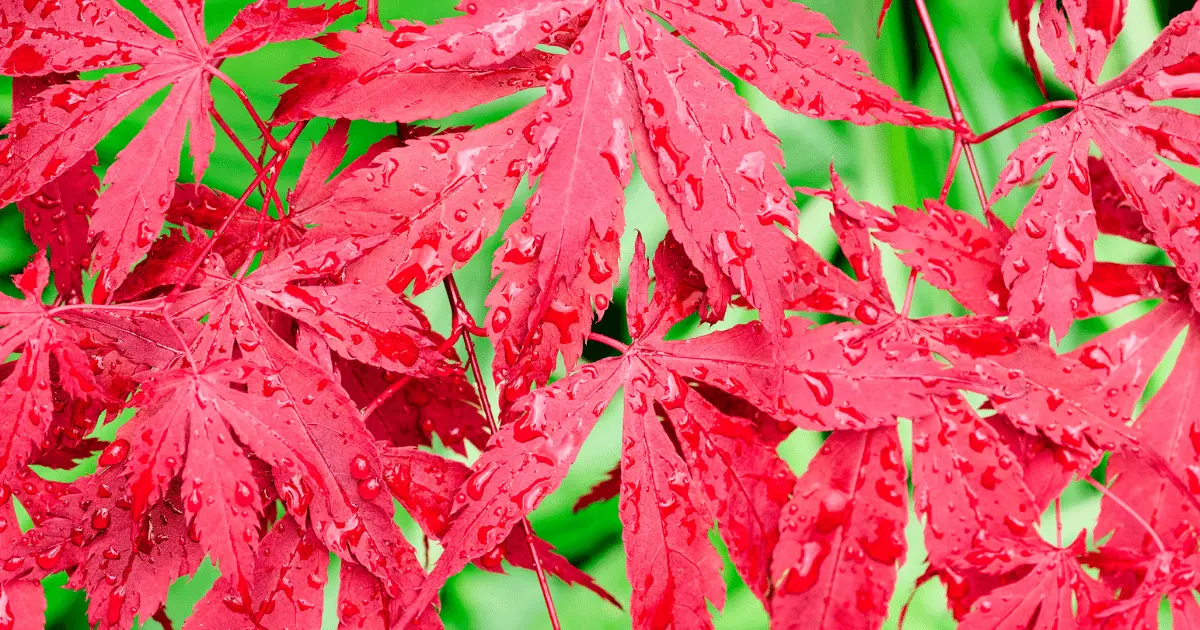
Acer Palmatum (Acer palmatum spp) is a popular and well-known Japanese maple with many purple and maroon forms, such as “Bloodgood.” It grows at a slow, moderate rate of 1 to 2 ft per year. They also grow fast when they are young and slow down when they reach maturity.
USDA Growing Zone: 5- 9
Sun Exposure: Full, partial
Soil Requirements: Slightly acidic, well-drained
6. Dahlia ‘Bishop of Oxford’
Dahlia ‘Bishop of Oxford’ is an herbaceous perennial famous for its flowers but also has tremendous purple leaves, stems, and flower buds. This plant blooms from July until frost and grows up to 36 inches (90 cm).
USDA Growing Zone: 8- 10
Sun Exposure: Full sun
Soil Requirements: Fertile, moist but well-drained soil.
7. Canna Lily ‘Purpurea’
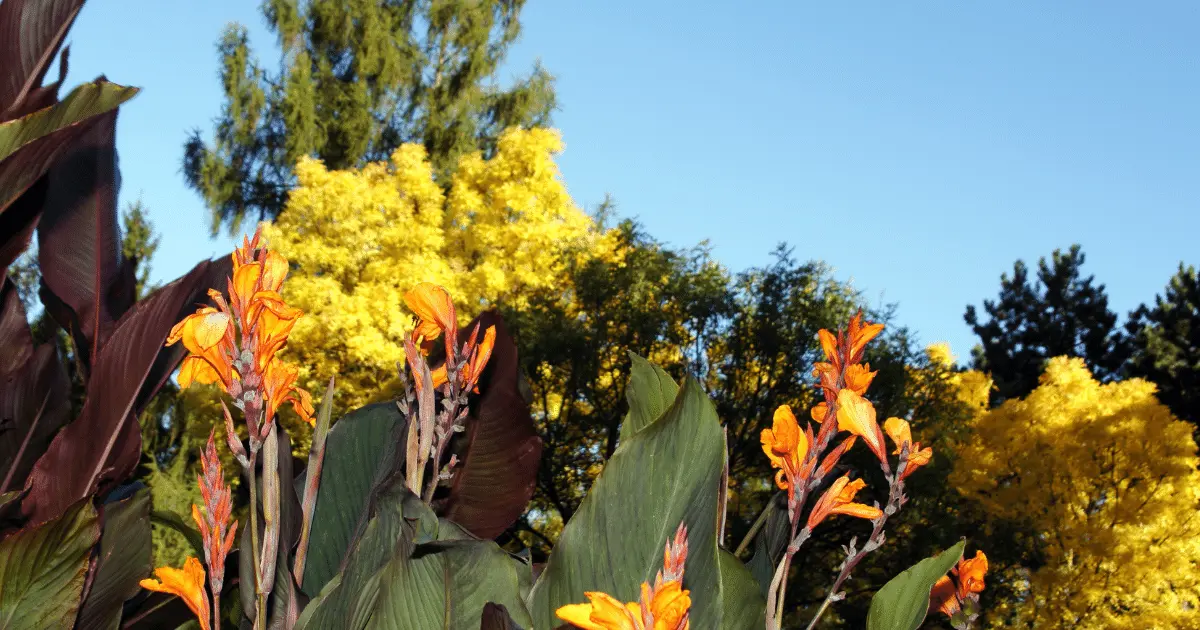
Canna lily (Canna indica ‘purpurea’), sometimes called “canna lilies,” are stunning tender perennials that provide a strong ornamental interest that thrives in the heat of July and August. Their flowers attract hummingbirds, and the leaves consist of oral, dark purple leaves with striking neon-red veins. This ornamental plant grows 4 to 7 ft (1.8- 2.1 m) tall and 3ft. (1m) wide.
USDA Growing Zone: 9- 10
Sun Exposure: Full sun
Soil Requirements: Rich, water-retentive, well-drained soils
8. Red Leaf Cordyline
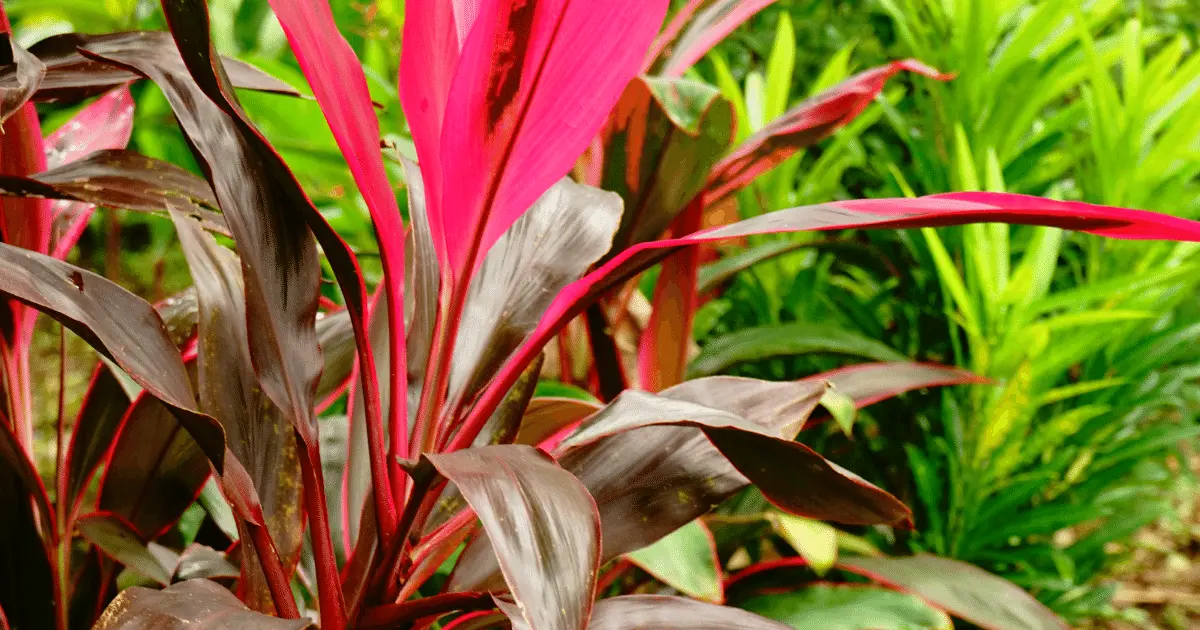
Red leaf cordyline (Cordyline fruiticosa ‘Rubra’) is a large evergreen, multi-stemmed tropical perennial with huge leaves ranging in a reddish-pink to burgundy-purple color. This evergreen plant thrives in moist soils as long as they are well-drained. They also prefer full sun or partial shade, growing up to 30 inches long and 4 to 6 inches wide.
USDA Growing Zone: 9 – 10
Sun Exposure: Full sun or partial shade
Soil Requirements: Deep, well-drained but moist soil.
9. Dwarf Barberry Shrubs
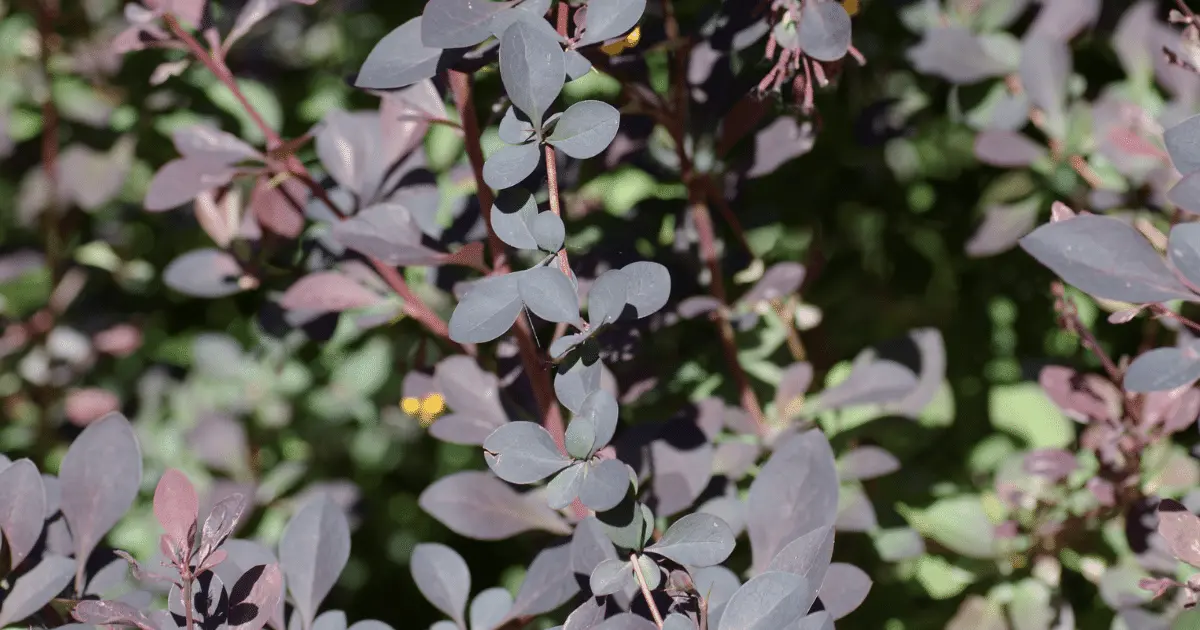
Dwarf barberry shrubs (Berberis thunbergii) are thorny bushes with small, oval reddish-purple leaves. They produce small, bright yellow flowers, smell nice, and contrast nicely with the leaves. Dwarf barberry shrubs can be planted in full sun and moist, well-draining soil.
USDA Growing Zone: 4 – 8
Sun Exposure: Full sun
Soil Requirements: Well-drained sand or clay soil
10. Purple Velvet Plant
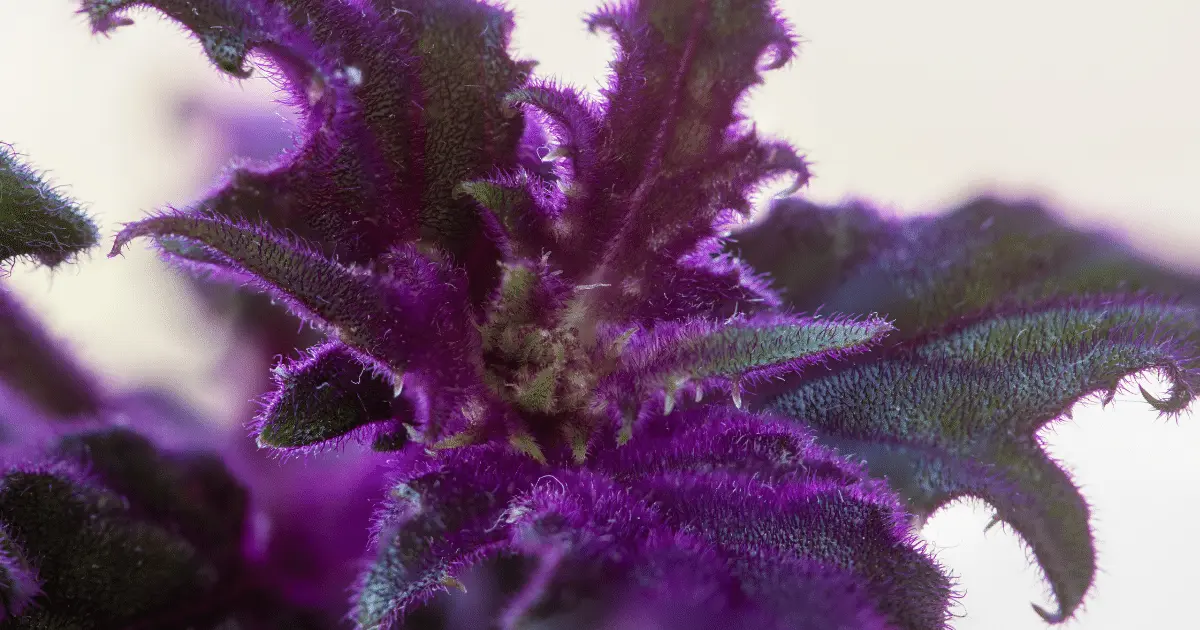
The purple velvet plant (Gynura aurantiaca), also called purple passion, is a woody perennial commonly found in American nurseries. It is related to Asters and comes from a very large genus of similar plants. This low-growing evergreen features fuzzy leaves with a dark green upper side and vivid purple underside.
Its trailing stems with purple and green velvety leaves can grow up to 2 ft (0.6 m) long. This stunning perennial should be grown in bright, indirect light to filtered sun.
USDA Growing Zone: 10-12
Sun Exposure: Part shade
Soil Requirements: Moist but well-drained soil.
11. Boat Lily
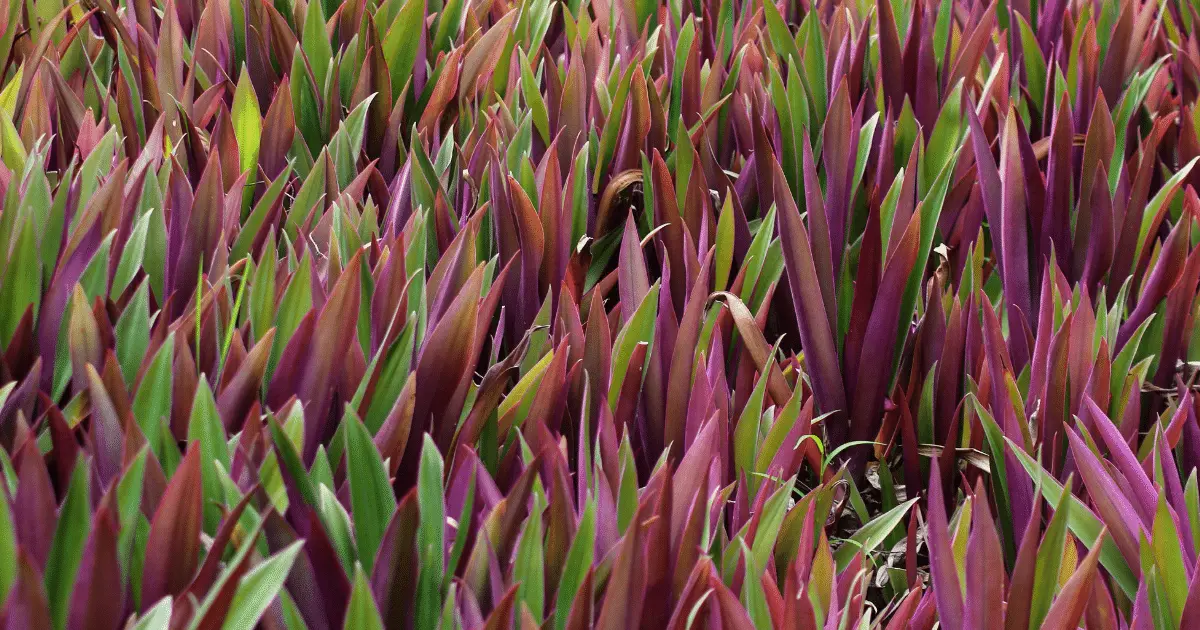
Boat lily (Tradescantia spathacea), also called “Oyster plant” or “Moses in the cradle,” is an evergreen perennial with sword-shaped dark green and purple leaves. Boat lily is loved for its unusual inflorescence and attractive foliage.
It is typically grown as a houseplant and can be in a patio plant brought inside during cold winters. These slender, pointed purple leaves grow in a rosette pattern and measure up to 12″ (30 cm) tall.
USDA Growing Zone: 9-11
Sun Exposure: Part sun or filtered sunlight
Soil Requirements: Well-drained soil
12. Wandering Jew
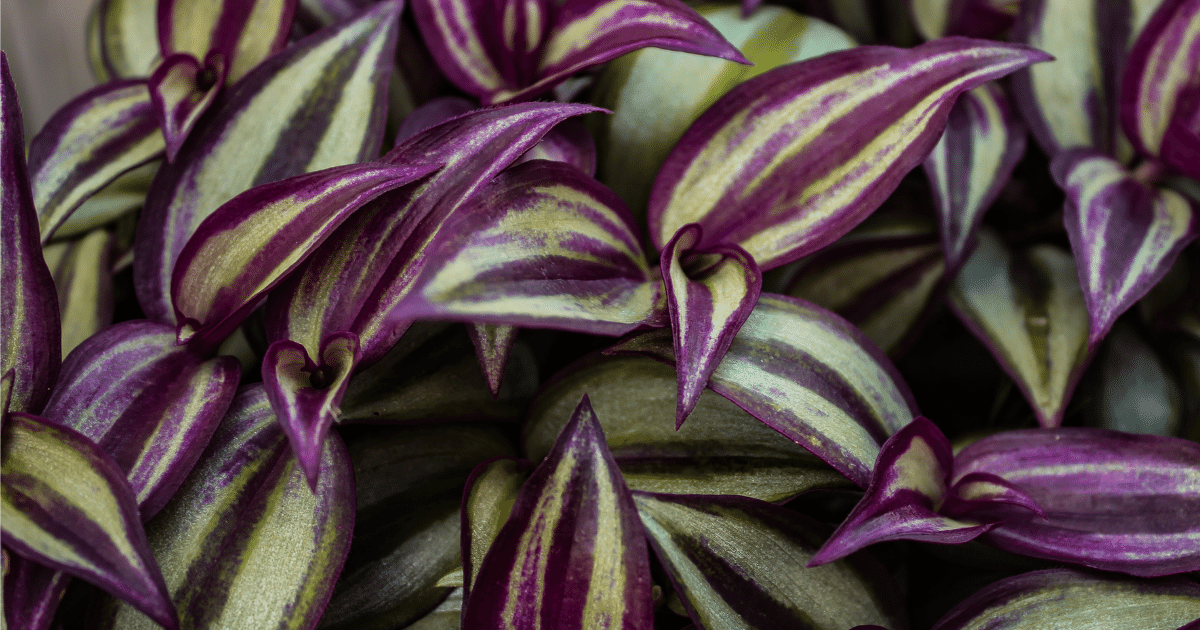
Wandering jew (Tradescantia zebrina), formerly known as “Zebrina pendula,” is a specie of creeping plant in the Tradescantia plants. It is popular in gardens as a ground cover and thrives best in moist, shady areas.
This variegated, purple-leafed plant has stripy leaves that are green and pale gray on the upper side and purple on the underside. The trailing vines grow up to 2 ft (0.6 m) long and can be grown in USDA zones 8 to 12.
USDA Growing Zone: 8-12
Sun Exposure: Filtered sun
Soil Requirements: Slightly moist
13. Ornamental Cabbage
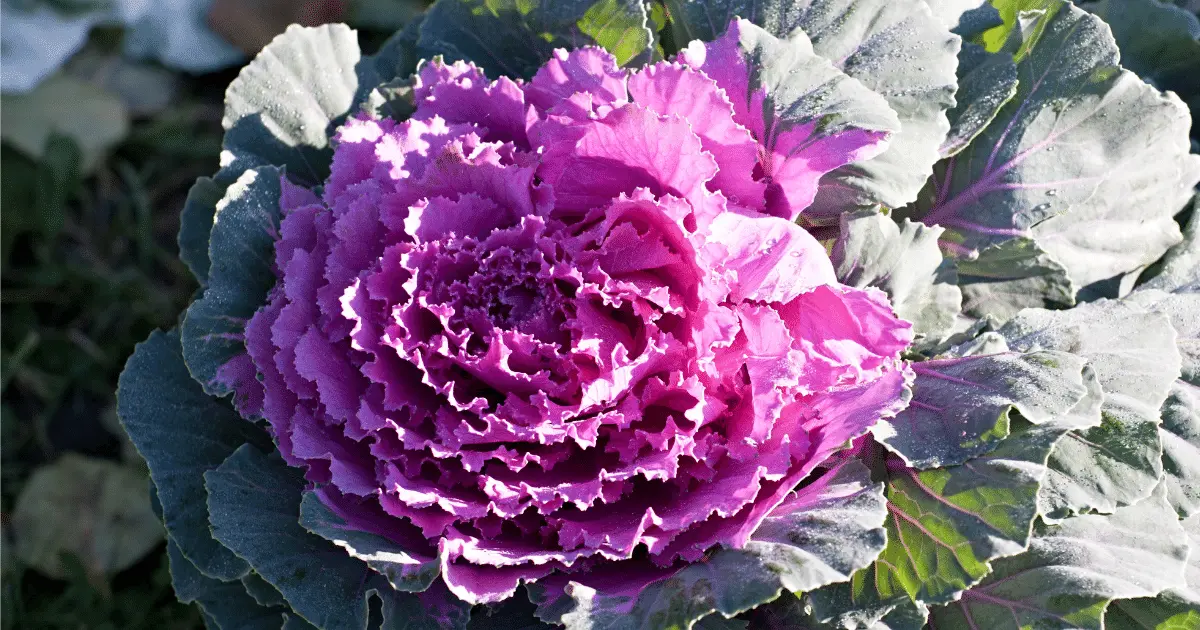
Ornamental cabbage (Brassica oleracea var. ace Phala), also known as “flowering cabbage,” is an annual plant with beautiful leaves that stand straight or spread out. This excellent season annual is easy to grow from seed or can be purchased at the garden center as fall approaches. Some stunning ornamental cabbage plants have white and green leaves with pale lilac centers, while others have blackish-purple leaves with a vibrant pink-purple center.
USDA Growing Zone: 2-11
Sun Exposure: Full sun
Soil Requirements: Well-draining and organically rich soil
14. Coleus

Coleus (Coleus spp) is a group of the stunning leafy plant known for their colorful ovate leaves with scalloped margins. Coleus’s height is approximately 1 to 2 feet, and the leaves are teardrop shaped with a bright purple center. Coleus plant varieties come in a wide range of cultivars that can be bright purple, reddish-pink, burgundy, and vibrant green colors.
USDA Growing Zone: 11
Sun Exposure: Full sun to medium shade
Soil Requirements: Rich, moist, loose soil, well-drained
15. Purple Leaf Cactus
Purple-leaf cactus have attractive fleshy green and purple leaves. They come in all shapes and sizes and add an exciting color twist to an indoor cactus garden.
USDA Growing Zone: 4-9
Sun Exposure: Full sun
Soil Requirements: Well-draining soil
16. Purple Emperor

Purple Emperor (Sedum telephium) is a hybrid stonecrop plant bred for the striking color of its foliage and flowers. It is ideal for foundation planting, adding color to beds and borders, or planting along fences or walls. The plant grows up to 1 to 2 ft (0.3- 0.6 m) tall. Its umbrella-shaped rosy pink flowers complement the purple foliage and add to the plant’s beauty.
USDA Growing Zone: 4-8
Sun Exposure: Full sun, partial shade
Soil Requirements: Light loamy soil
17. Purple Leaf Weigela
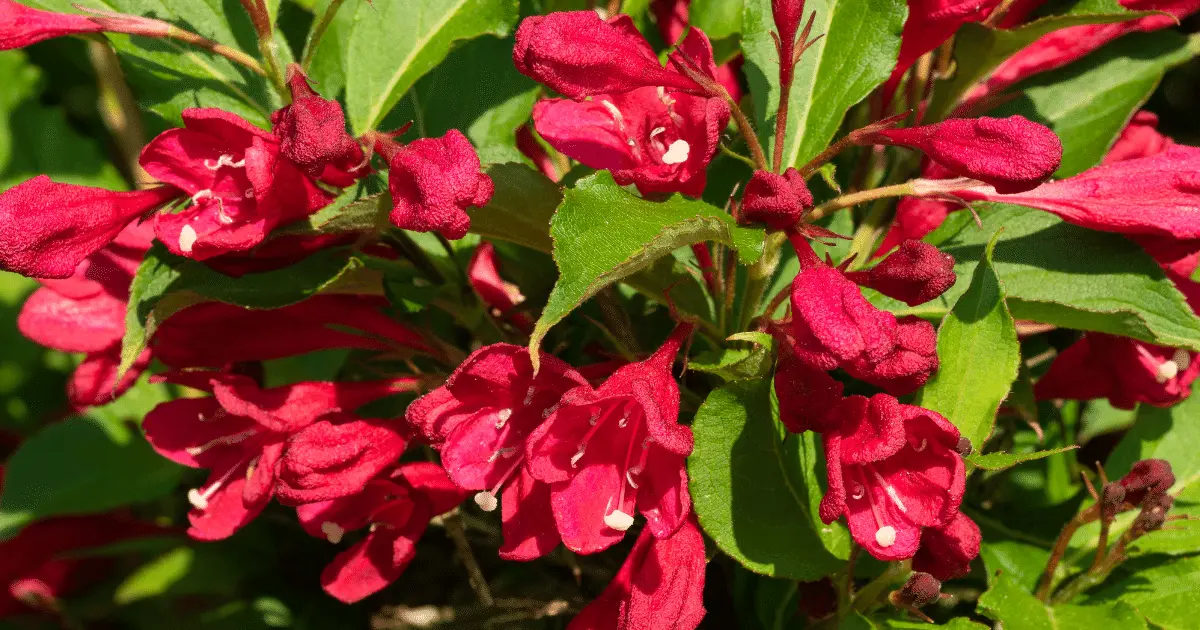
Purple leaf weigela (Weigela florida ‘Alexandra’) is a medium-sized shrub great for drama, height, and wonderful contrasting foliage. Its rosy-pink trumpet-shaped-flowers keep their eye-catching colors throughout the season, growing up to 4 to 5 ft (1.2-1.5 m) tall in USDA zones 4 to 8.
USDA Growing Zone: Zone 4 to 8
Sun Exposure: Full sun
Soil Requirements: Moist, well-draining soil
18. Forest Pansy
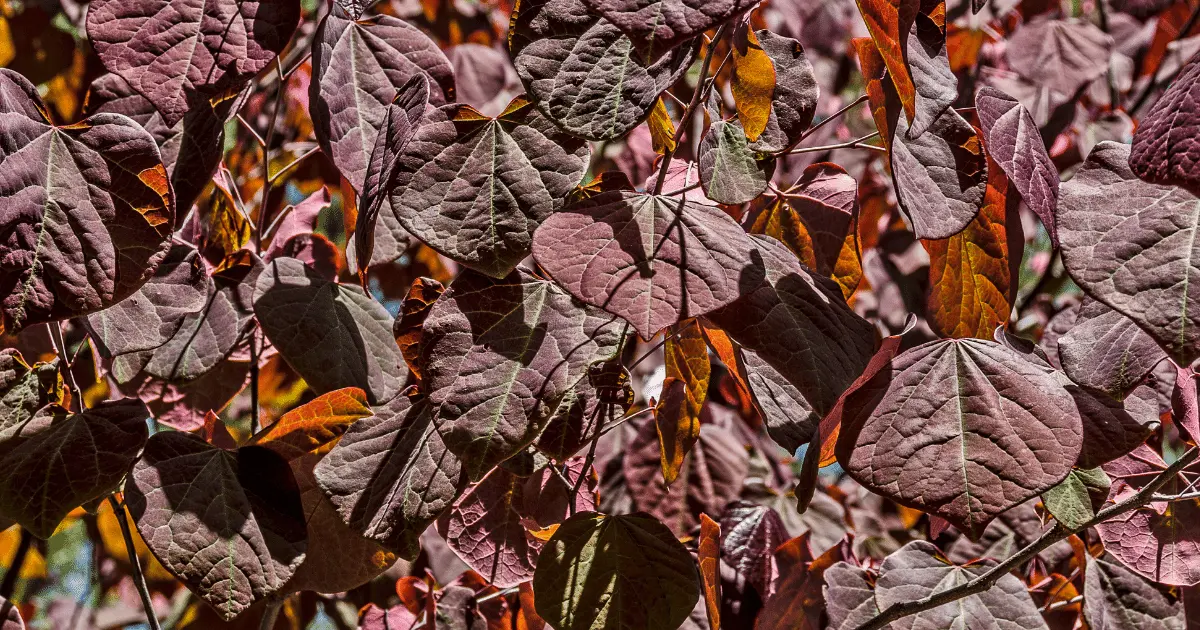
Forest pansy (Cercis Canadensis) is a versatile plant grown as a shrub or a small multi-stemmed tree. It is often found in woodlands and along rocky stream beds. The leaves grow up to 12 cm in width, broadly heart-shaped in deep red-purple, turning a shade of orange, bronze, and red-purple in autumn.
USDA Growing Zone: 6-8
Sun Exposure: Full sun, dappled shade, partial shade
Soil Requirements: Well-drained, light, sandy, clay, heavy, or moist soil.
19. Midnight Rose
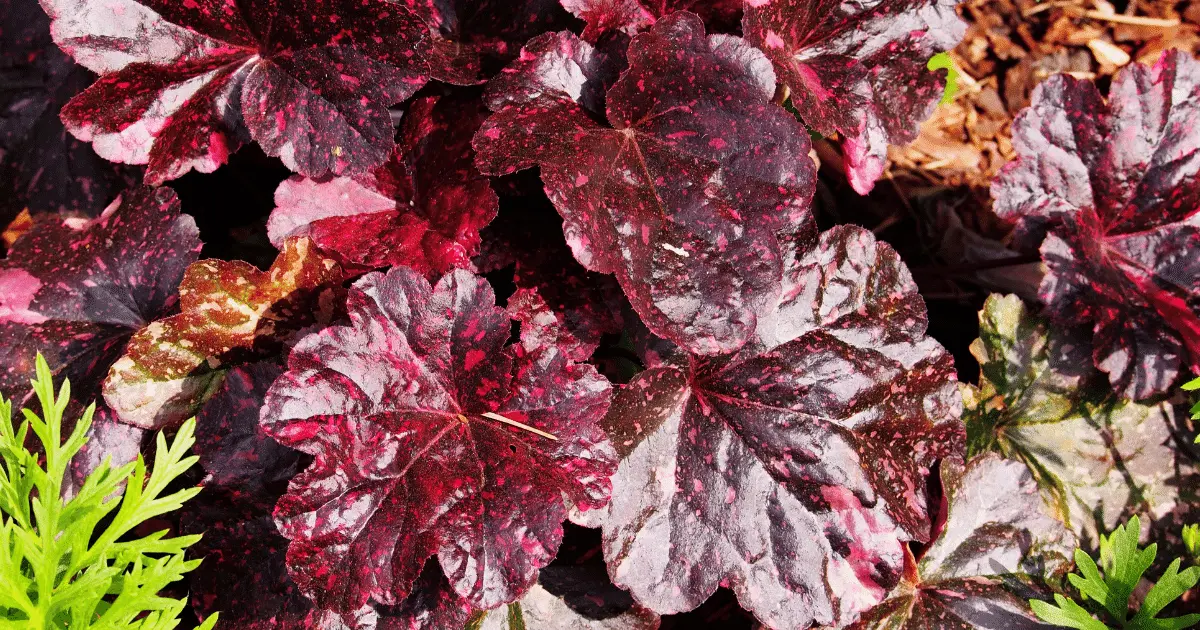
Midnight rose (Heuchera) is a clump-forming perennial with attractive rounded, shallowly palmately lobed leaves and small tubular flowers. Midnight rose grows to 10 inches tall (25 cm) with a spread of 16 inches (40 cm). It thrives best in part shade, rich humusy, medium moist, and well-drained soils.
USDA Growing Zone: 6-8
Sun Exposure: Full sun, dappled shade, and partial shade
Soil Requirements: Rich, humusy, medium moist, and well-drained soils
20. Royal Purple
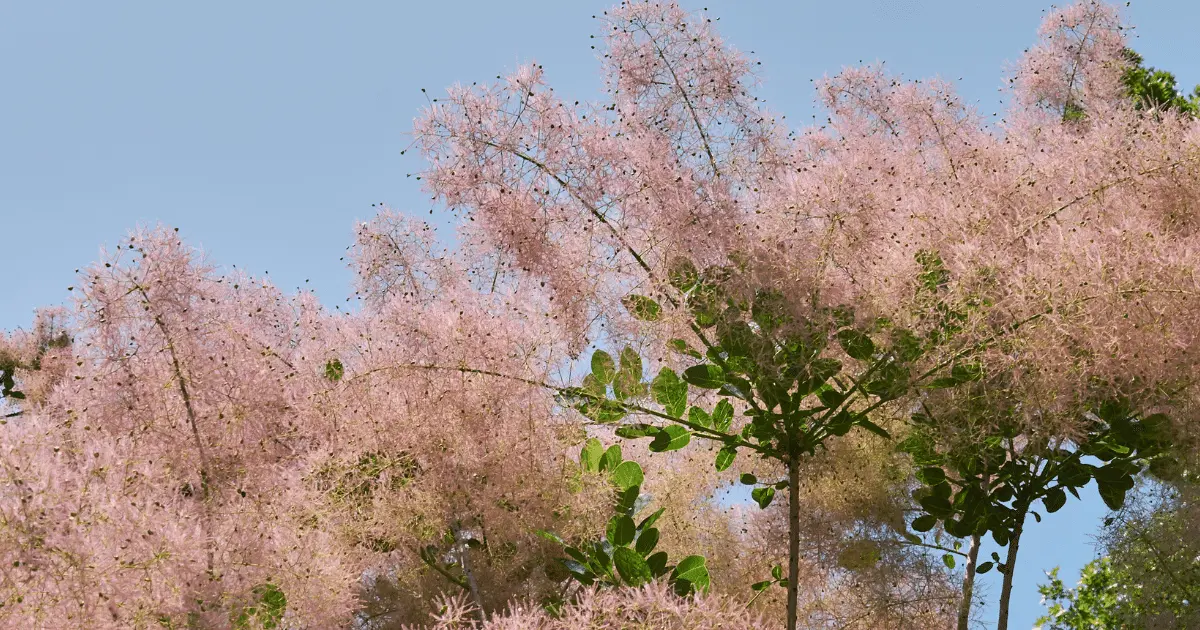
Royal purple (Cotinus coggygria) is a bushy large deciduous shrub cultivated for its attractive foliage of rounded leaves. The tree grows to about 12-15 ft (3.5- 4.5 m) tall and nearly double in width.
USDA Growing Zone: 4-9
Sun Exposure: Full sun, partial shade
Soil Requirements: Loam, clay, and sand soil
21. Oakleaf Hydrangea
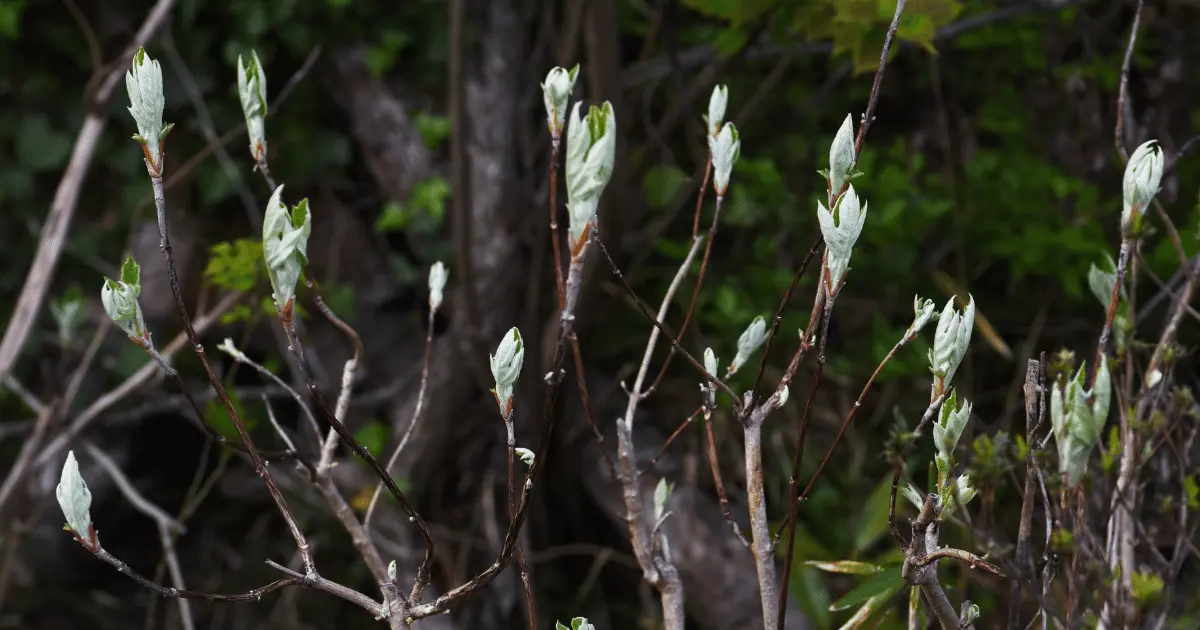
Oakleaf hydrangea (Hydrangea quercifolia) is a deciduous or evergreen shrub that blooms large, magnificent, conical flower heads from late spring to midsummer up to 12 inches (30 cm). It can thrive in full sun or part shade and is best grown in fertile, moist, acid, well-drained soils.
USDA Growing Zone: 5-8
Sun Exposure: Full sun
Soil Requirements: Fertile, moist, acidic, well-drained soils.
22. Purple Leaf Filbert
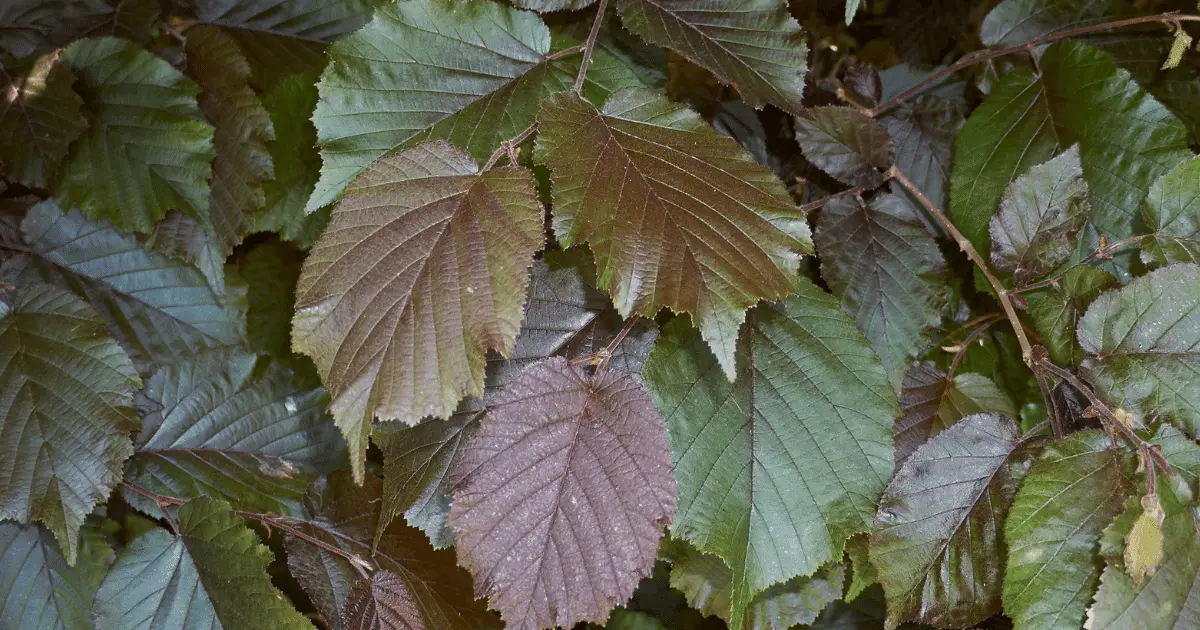
Purple leaf filbert ( Corylus maxima) are large bushy shrubs with a dark purple color to both stems and leaves. It grows up to 25 inches tall and half as wide.
USDA Growing Zone: 4-8
Sun Exposure: Full sun, partial shade
Soil Requirements: Moist, free-draining soil
23. Sambucus Black Beauty
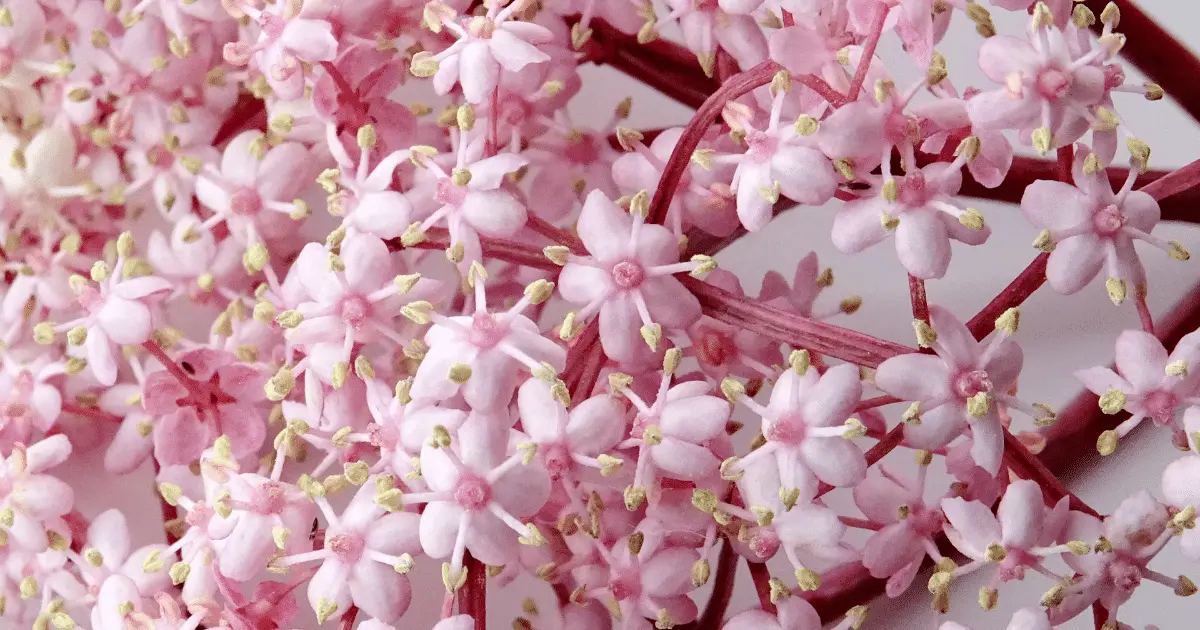
Sambucus black beauty (Sambucus nigra ‘Gerda’) has almost black foliage and sweet lemon-scented, pale pink flowers in early summer. It is widely grown in moist, well-drained soil from full sun to partial shade.
USDA Growing Zone: 4-8
Sun Exposure: Full sun, partial shade
Soil Requirements: Moist, well-drained soil
24. Purpurea

Purpurea (Bauhinia purpurea) is a tropical, evergreen small tree or shrub that grows up to 4-10 m tall and 2 m across. It can grow in many vegetation types, such as evergreen lowland rain forests and disturbed areas, the secondary forest along roadsides, and gardens.
USDA Growing Zone: Zone 10
Sun Exposure: Full sun
Soil Requirements: Full sun to partial shade
25. Brunette Bugbane
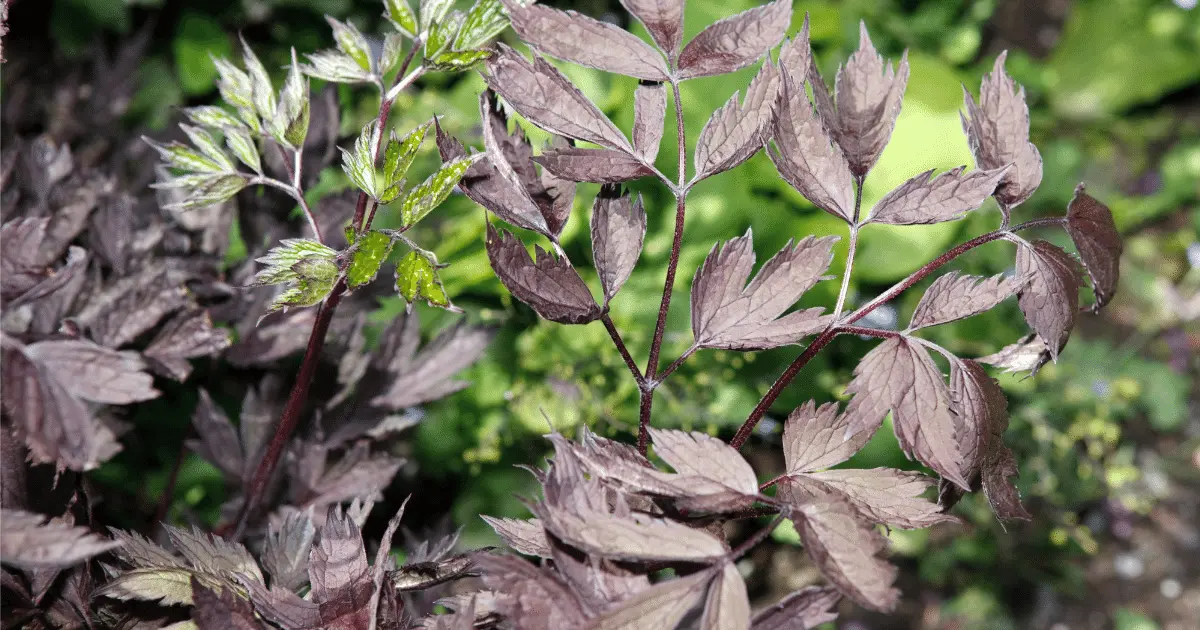
Brunette Bugbane (Cimicifuga racemosa) is an herbaceous perennial loved for its stunning spikes of white flowers with shell-pink overtones. It grows about 4 feet tall at maturity with a spread of 3 feet.
USDA Growing Zone: 4a-8a
Sun Exposure: Partial shade
Soil Requirements: Well-drained soil
26. Smoke Tree
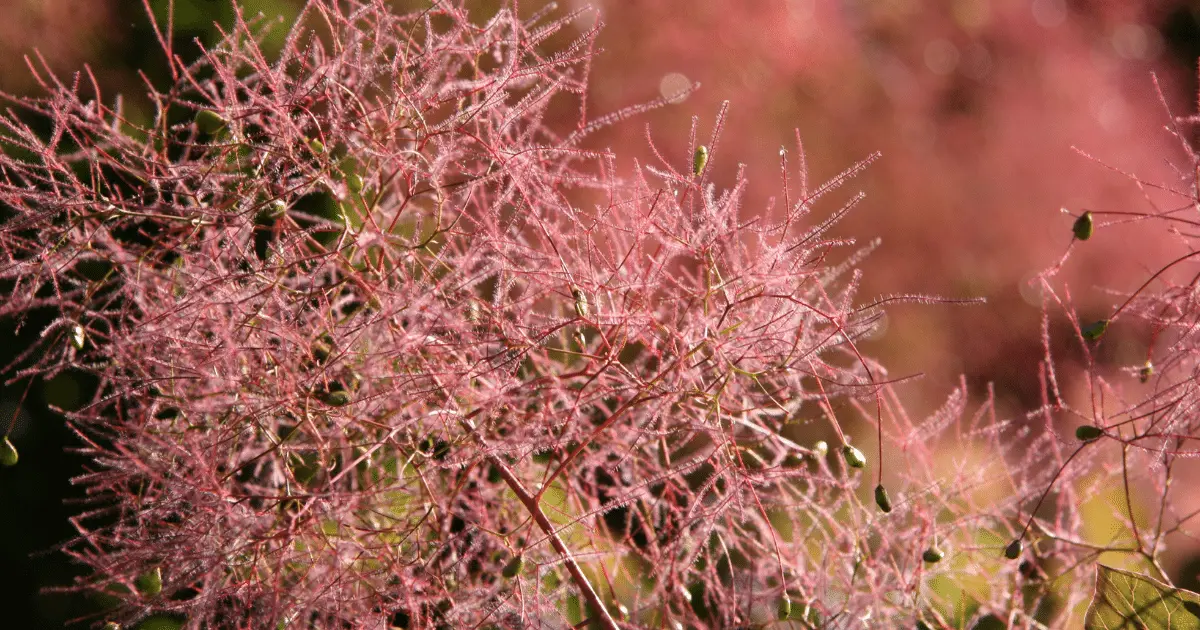
Smoke Tree (Cotinus), also called “Smoke bush,” is grown as a large shrub or small tree that offers oval leaves in shades of rich purple, gold, or green throughout the gardening season.
USDA Growing Zone: 5-8
Sun Exposure: Full sun, partial shade
Soil Requirements: Acidic, alkaline, loamy, sandy, well-drained, and clay soils.
27. Black Scallop Bugleweed

Black scallop bugleweed (Ajuga reptans) is a creeping perennial with dark purple, almost black, shiny scalloped leaves. It has glossy purple foliage that dramatically colors a garden landscape. This hardy, attractive plant grows to about 4 to 6 inches (121-15 cm) and spreads up to 12 inches (30 cm).
USDA Growing Zone: 3-9
Sun Exposure: Full sun to partial shade
Soil Requirements: Medium moisture, well-drained soils
28. Chinese Fringe Flower
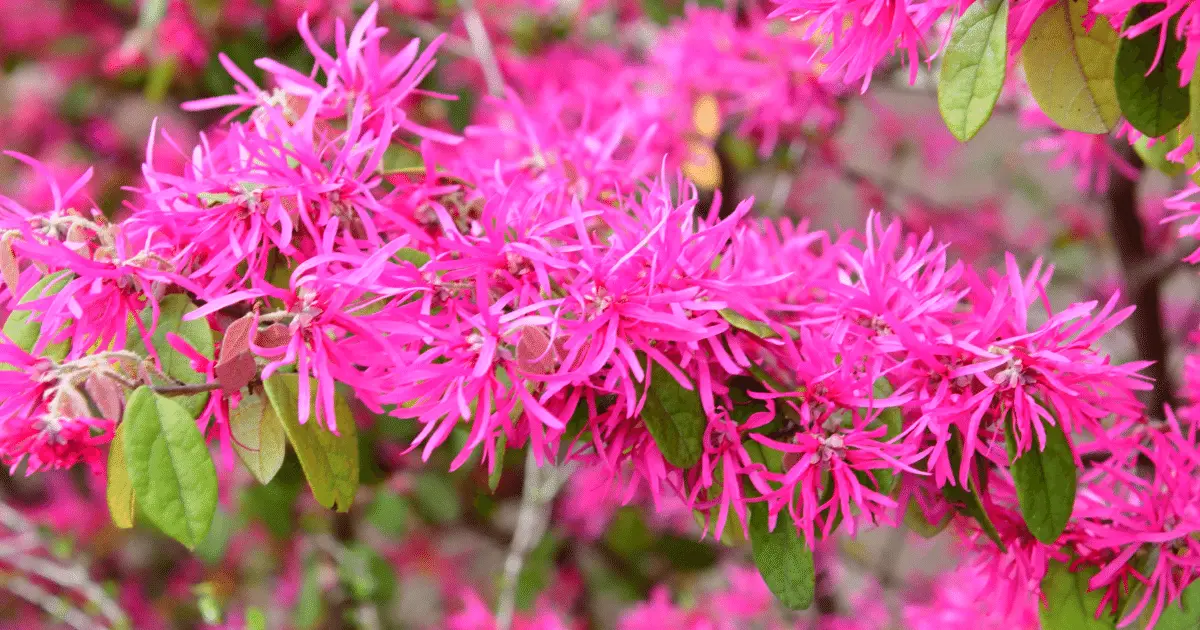
Chinese fringe flower (Loropetalum Chinese) is an evergreen shrub noted for its dark purple-burgundy leaves and brightly colored delicate red flowers with spindly petals. It grows up to 6 ft (1.8 m) tall.
USDA Growing Zone: 7-9
Sun Exposure: Full sun to light shade
Soil Requirements: Moist, organically rich, well-drained soil.
29. Purple Congo
Purple congo (Philodendron) is an attractive plant with gorgeous purple foliage. The leathery leaves emerge from deep burgundy before turning purplish-black, then rich green. This easy-to-care-for houseplant grows about 2 ft (0.6 m) tall and wide.
USDA Growing Zone: 12
Sun Exposure: Bright, indirect light
Soil Requirements: Moist, well-drained, and acidic soil
30. Crimson Pygmy Barberry

Crimson pygmy barberry (Berberis thunbergii var. autropurpurea ‘Nana’) is a deciduous dwarf shrub with purplish-red foliage on reddish-brown stems.
USDA Growing Zone: 4-8
Sun Exposure: Partial to full sun
Soil Requirements: Well-drained sand or clay soil.
